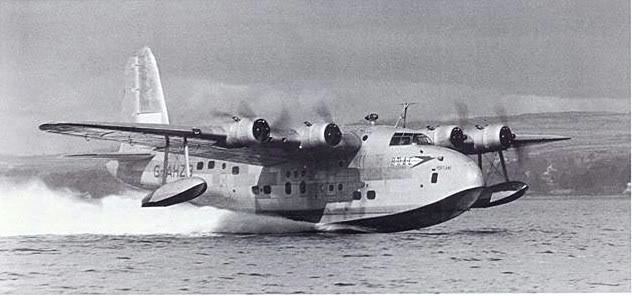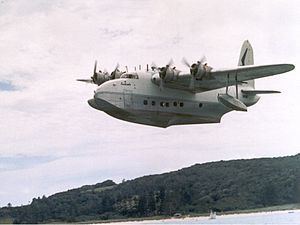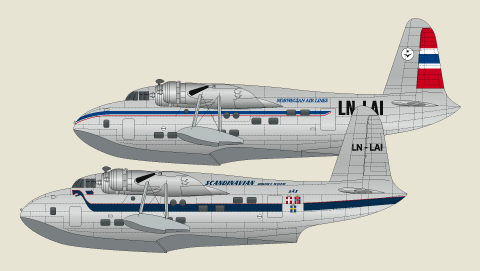Top speed 332 km/h Length 26 m Engine type Radial engine | Wingspan 34 m Introduced 1938 First flight October 16, 1937 | |
 | ||
The Short S.25 Sandringham was a British civilian flying boat produced during the Second World War by the demilitarized conversions of Short Sunderland military flying boats previously operated by the Royal Air Force.
Contents
- Design and development
- Civil operational use
- Preserved Sandringhams
- Variants
- Operators
- Specifications Sandringham 5
- References

Design and development

From late 1942, several RAF Sunderlands were stripped of their armament and fitted with bench-type seats. From early 1943, the aircraft gradually acquired civil markings and went into service with BOAC between Poole Harbour, Dorset and West Africa. A BOAC Sunderland made a proving flight to Karachi in the Indian subcontinent in late 1943 to research future civil operations to India. These conversions were designated by Shorts as the Sunderland 3.

All the Sandringhams were civil conversions of former Royal Air Force Coastal Command Short Sunderlands. The Sandringham Mark 1 used Bristol Pegasus engines, while the later marks of Sandringham used Pratt & Whitney "Twin Wasp" engines. The conversions were carried out by Short and Harland Ltd at Belfast Harbour.

In 1963 an additional conversion of a former Royal New Zealand Air Force Sunderland V was carried out by Ansett with a 43-seat interior, although described as a Sandringham the Islander was a unique design.
Civil operational use

Following VE-Day, the BOAC Sunderlands were stripped of camouflage, their Pegasus engines upgraded to Mark 38 (later 48) and interiors modified to carry 24 day or 16 night passengers plus 6,500 lb (2,830 kg) of mail. This initial conversion was known by BOAC as their "Hythe" Class.

The Sandringham 5 was operated by BOAC from 1947 as the "Plymouth class" on the Far East routes from Southampton via Alexandria to Hong Kong and Tokyo. These were replaced by Lockheed Constellation land planes during 1949. TEAL used Sandringhams on the Auckland to Sydney route and flights to Pacific Islands. In 1950, Qantas introduced the first of five aircraft which flew from the Rose Bay flying boat base on Sydney Harbour to destinations in New Caledonia, New Hebrides, Fiji, New Guinea and Lord Howe Island. Two of these were purchased from TEAL and the other three were purchased from BOAC. These were in service through to 1955.
The type was used by Ansett Flying Boat Services on the Sydney (Rose Bay) to Lord Howe Island scheduled service until 1974. One of Ansett's Sandringhams was converted from a S-25 Sunderland previously owned by the Royal New Zealand Air Force. It was also used in Norway by DNL - Norwegian Airlines 1946–1952 on the domestic service from Oslo to Tromsø, and in Uruguay by Compañía Aeronáutica Uruguaya S.A. (CAUSA) on the passenger services between Montevideo and Buenos Aires (1950–1962).
In October 1954, Captain Sir Gordon Taylor flew his newly acquired Sandringham 7 from the UK to Australia to begin a series of flying boat cruises of the south Pacific. The aircraft later passed to Réseau Aérien Interinsulaire in Tahiti and is now stored at the Musée de l'Air et de l'Espace at Paris Le Bourget.
One of the last operators of the Sandringham was Antilles Air Boats in the Virgin Islands of the Caribbean which flew the aircraft in scheduled passenger service during the 1970s with flights from the Charlotte Amalie Harbor Seaplane Base on St. Thomas and the Christiansted Harbor Seaplane Base on St. Croix among other destinations.
Preserved Sandringhams
Ex-Ansett Sandringham (RAF Serial ML814 Short Sunderland MR5) c/n SH.974b.) To RNZAF No.5 Squardron 1953 Fiji and became NZ4108. Hobsonville, New Zealand 1956-1963. Sold 1963 to Airlines of New South Wales. Converted to passenger configuration and registered VH-BRF and named Islander. To Antilles Air Boats, Virgin Island as N158J in 1974. To Edward Hulton in the UK in 1979 as G-BJHS. Storm Damaged and repaired. Sold to Kermit Weeks in 1992 and re-registered N158J. On display at the Fantasy of Flight museum in Polk City, Florida, USA with Kermit Weeks and registered as N814ML on 16 September 1993.
Ex-Ansett Sandringham (RAF Serial JM715 Short Sunderland Mk III) flew for Tasman Empire Airways Ltd. (TEAL) of New Zealand purchased JM715 from the Air Ministry for conversion. After conversion at Short's Belfast factory, the aircraft was allocated the conversion number SH.55C and registered to TEAL, delivered from Southampton to Waitemata Harbour, Auckland on 29 October 1947 and was soon in service on the 1,300-mile Sydney–Auckland route. In May 1950, ZK-AMH, was sold to Barrier Reef Airlines of Australia where it was renamed Beachcomber and registered VH-BRC. Barrier Reef Airlines were subsequently taken over by the major Australian airline Ansett and became Ansett Flying Boat Services and operated out of Rose Bay, Sydney, Australia until 1974. The vast amounts of money required to keep the aircraft in flying condition were not available and in 1981, the aircraft was purchased for the National Aeronautical Collection by the Science Museum and is now on display at Solent Sky museum in Southampton, Hampshire, UK.
Short S-25 Sandringham 7 Bermuda Class. c/n SH-57C. Built as a (RAF Serial JM719 Short Sunderland Mk III). Converted to Short S-25 Sandringham 7 Bermuda Class 1947 for BOAC British Register as G-AKCO "ST. George". Sold to Sir Patrick Gordon Taylor 1954. Registered VH-APG "Frigate Bird III". Sold to Reseau Aerian Interinsulaire 1958. Registered F-OBIP. Final Flight 1970 Papeete, Tahiti. Initially donated to Queensland Air Museum 1975. Relocation proved cost prohibitive. Acquired by Musée de l'Air et de l'Espace at Le Bourget Airport, 1977. Transported by French military to Paris in 1979. Under restoration. Not currently (2008) viewable by the public.
Variants
Operators
Specifications (Sandringham 5)
Data from British Civil Aircraft 1919-1972
General characteristics
Performance
